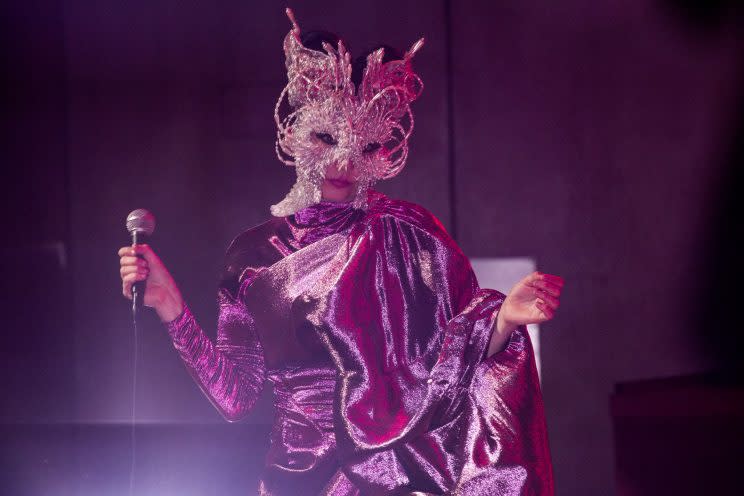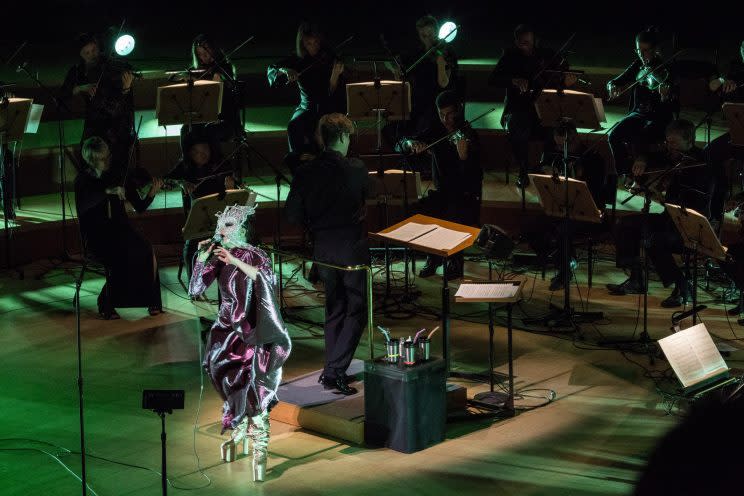Bjork Shows Off Masked Face, Unmasked Emotions, With L.A. Philharmonic

Whatever natural skepticism you might have when a rock musician teams up with a symphony orchestra — who’s slumming with who, exactly? — goes right out the window when that artist is Bjork, who’s been as effective as anyone in the 21st century at rendering irrelevant the lines between high and pop art. Her show with a 32-piece string orchestra on Tuesday at Walt Disney Concert Hall was the cross-disciplinary event of the year: classy, if not strictly classical, and as emotionally raw as any rock ‘n’ roll gets. Bjork + orchestra = putting the guts back in gut strings.
“This is kind of emotional for me,” Bjork said, in her few words from the stage, it being “my last Vulnicura concert. It’s been two years, about.” It’s been 27 months, in fact, since Bjork premiered the material from that album at a Carnegie Hall concert, but the shows since then have been rare and anything but standardized. Back then, she was reproducing the record’s mixture of orchestration and programming with a 15-piece string ensemble and a few electronic musicians. But for one-nighters in just four cities in the last year — in London, Iceland, Mexico, and now, for the only time in the U.S., Los Angeles — she ditched the electronica and doubled the size of the orchestra, making for a purer and more astonishing experience.

Fans were well aware of the rarity: tickets that originally topped out around $200 were being resold for four to five times face value, when they could be found at all. (Disney Hall has a capacity of just under 2300, less than half the size of the Royal Albert Hall, not exactly an arena itself, where Bjork did this show last September.) But there is a more populist, or at least more accessible, component to Bjork’s current “tour”: “Bjork Digital,” a (mostly) virtual-reality video exhibit taking place under the L.A. Phil’s auspices at downtown’s Magic Box at the Reef through June 4.
“I kind of am very fond of extremes, as you probably noticed,” Bjork said at a press conference heralding the two L.A. events, so it’s fair to say the irony in these conjoined events is not entirely coincidental: “Bjork Digital” makes use of up-to-the-moment 21st century technology, while Tuesday night’s completely screen-free event reveled in the very latest in 17th century tech.

Weirdly or counter-intuitively enough, both the symphony show and the digital exhibit serve about equally to emotionally amplify Vulnicura, a self-described “heartbreak album” that will go down as one of pop’s most indelible Divorce Records. (She may not have been literally married to the father of her child, whose exit after a decade-long relationship inspired this chronological song cycle, but close enough.) For all the high-art trappings of either the formal concert hall or the art exhibit, the content at the core of the songs is pop music at its most direct and elemental: “I’ve never really done lyrics like this, because they’re so teenage, so simple,” she said when the album came out. Vulnicura represented a pretty severe act of self-unmasking — which maybe explains why Bjork wore a pair of elaborate masks for the duration of Tuesday’s concert: A gal’s gotta maintain a little mystery, right?

Bjork is better than any science fiction director could be at embodying what it means to be fully alien and fully human all at once. The spotlights on far ends of the orchestra ensured that Bjork’s full-body shadow would be cast sideways on the wood paneling on either side of the Disney Hall stage — shadows which, with her elaborate headgear, made it appear as if Maleficent or some H.R. Giger creation were lurking around a corner. There’s a slightly alien quality to the Icelandic tonality of much of her music, too. But you could hardly ask for a more recognizable form of mortality as we know it than Bjork pleadingly singing “Show me emotional respect” or “Maybe he will come out of this loving me, maybe he won’t” or the downright prosaic “Family was always our sacred mutual mission, which you abandoned… I’m drowned in sorrows.” Slightly scary avatars don’t come any more warm-blooded than Bjork.

If there’s a complaint you could make about Vulnicura as an album — assuming its sorrowfulness doesn’t put you off to begin with — it’s that its bountiful string arrangements could feel a little chilly. The programmed percussion effects may have compounded that, even though the beats had an effect of helping provide some contextualizing form to songs that could otherwise feel a little tuneless the first time you heard them. In concert, stripping away all trace of the electronics (as she also did in a remix album, Vulnicura Strings) was a welcome move.
“I just came from Mexico a month ago, and that orchestra had a totally different sound, really relaxed and earthy and dark,” she said at the recent press conference. “And I’m very excited to work with L.A. musicians… I think it’s a way to get the locals and the local sounds into the exhibition and into the concerts.” She again referred to “the locals” when acknowledging the L.A. Phil, and while it’s hard to know exactly how different this orchestra’s tone was than in other cities, the effect was to give this music a much warmer and more moving effect than it’s had in any previous recorded incarnations.

The first set was devoted to the first six songs from Vulnicura, in order. Sometimes the strings played suspenseful eighth notes right out of a Hitchcock movie, in “Notget”; sometimes they played one seemingly endless, discordant tone that gave way to a cello solo, while Bjork’s voice provided all the melody in “Family”; sometimes there was enough melodic richness to go around for everybody, in “Stonemilker.” This was like few other symphonic Disney Hall concerts, and not just because the Philharmonic probably hasn’t accompanied many other performers singing the F-word, as Bjork does (sadly and unemphatically) in “History of Touches.” The audience yelped in a very non-classical style each time she strolled on stage, and didn’t always recognize that the pauses in the 10-minute-plus “Black Lake” did not actually mark the end of the composition. But there was just the right combination of screamed “I love you, Bjork!” and appropriate rapt silence as she paced the stage for this, apparently the official final funeral service for that particular relationship.
Set two consisted of five fantastically orchestrated Bjork oldies from the 1990s and 2000s — “Aurora,” “I’ve Seen It All,” “Joga,” “Vertebrae,” and “Bachelorette” — followed by the final two songs from Vulnicura, with an encore made up of two more classics, “Anchor Song” and “Pluto.” In the end, you might’ve found yourself wishing for the Phil to take on the consuming task of interpreting her entire catalog, Sugarcubes possibly included.

But that won’t be what fans get next. She returns to L.A in less than two months to play the FYF Festival, sans the Philharmonic. “I’m going to come in July [on the 21st] with [producer] Arca, and with a 15-piece orchestra,” she said at her press conference, “and we’re going to perform sort of stompers, if you will, and that’s going to have a lot of visuals and surprises and special effects… I really enjoy especially doing those festivals with Arca, where we play more of my old songs and it’s kind of celebrational and happy. Obviously there are sometimes tens of thousands of people watching, so that’s kind of more of an outdoors, communal experience where you can lose yourself — very different to the orchestra shows where you are sitting in a chair in an orchestra room.”
Happy, festive Bjork? We’ll take her — if we must — but the 2300 at Disney Hall won’t ever forget all that heart-wrenchingly cathartic chair-sitting.
In the meantime, fans are advised to get to the digital exhibit, which is a surprisingly stirring experience, once you forget you’re wearing some of the clunkiest headgear modern tech still has yet to overcome. Having an unmasked Bjork sing literally in your face, in the round, for the 10 minutes of “Black Lake” is almost too intimate an experience to handle, but little do you know that you’re going to get even further inside Bjork — or the digitalized, star-child version of her — in some of the spacier VR videos to follow.
She and her directors do a remarkable job of taking as much of the “virtual” out of virtual reality as possible, somehow ensuring that in the exhibit, as in the Philharmonic performance, it’s ultimately even more about the emotional revelation than the very striking trappings.

